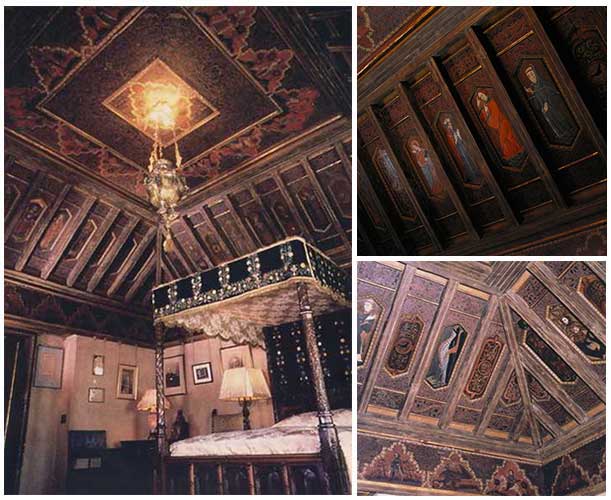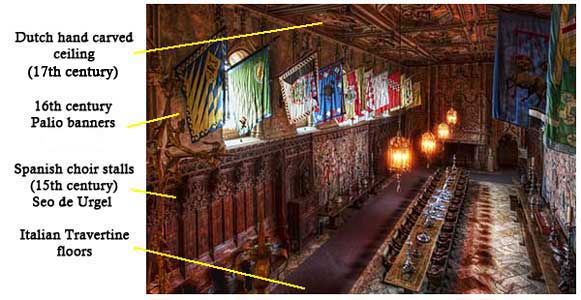
Mientras indagaba para la biblioteca de Jay Walker hace unos días, tropecé con una sorprendente información sobre artesonados mudéjares aragoneses en el castillo de Hearst en California, y sentí curiosidad.
Seguir leyendo...El Castillo de Hearst en San Simeón, California
Propiedad: 160 km²
La superficie total de los edificios superan los 8.300 m².
 Casa grande, el "castillo", 5.634 m² (38 dormitoriso, 41 baños, 19 salones)
Casa grande, el "castillo", 5.634 m² (38 dormitoriso, 41 baños, 19 salones)
 Casa del Mar: 546 m² (6 dormitorios)
Casa del Mar: 546 m² (6 dormitorios) Casa del Monte: 213 m² (4 dormitorios)
Casa del Monte: 213 m² (4 dormitorios) Casa del Sol: 399 m² (8 dormitorios)
Casa del Sol: 399 m² (8 dormitorios)Además de 0,5 km² de jardines, piscinas tanto interiores como exteriores, pistas de tenis, un cine, un aeródromo, y el zoológico privado más grande del mundo.
(Hearst Castle, San Simeon, CaliforniaEstate: 240, 000 acres.
The total area of the castles exceeds 90,000 square feet.
Casa Grande, the "castle", 60,645 square feet (56 bedrooms, 61 bathrooms, 19 sitting rooms).
Casa del Mar: 5,875 square feet
Casa del Monte: 2,291 square feet
Casa del Sol: 2,604 square feet
In addition, 127 acres of gardens, indoor and outdoor swimming pools, tennis courts, a movie theater, an airfield, and the world's largest private zoo.)
George Hearst, un minero rico, compró en 1865 40.000 acres de tierra que incluían los ranchos mejicanos de Piedras Blancas, San Simeón y Santa Rosa. "Estoy cansado de mi rancho, de acampar al aire libre, quiero algo más cómodo, me gustaría construir una casita" le dijo a la arquitecto Julia Morgan en 1919 – la primera mujer del mundo (otra "primera mujer" que no conocía) en obtener un diploma de la Escuela de Bellas Artes de Paris, la mejor escuela de arquitectura. Sin embargo, George Hearst terminó construyendo un castillo de 165 habitaciones y 127 acres de jardines, terrazas y piscinas. Ese mismo año, el castillo fue heredado por su hijo y único heredero W.R. Hearst quien siguió construyéndolo hasta 1947.

(George Hearst, a wealthy miner who bought in 1865, 40,000 acres of land that included the Mexican Ranchos of Piedras Blancas, San Simeon and Santa Rosa. "I'm tired of my ranch, camping outdoors, I want something more comfortable, I would build a house," he told the architect Julia Morgan in 1919 – the first woman in the world to obtain her diplôme from the École des Beaux-Arts in Paris, the finest school for architects. George Hearst ended up building a house of 165 rooms and 127 acres of gardens, terraces and pools. In the same year, the castle was inherited by his son and sole heir W.R. Hearst, who continued to build until 1947.)
Hearst llamó la propiedad "La Cuesta encantada", pero generalmente se refería a ella como "el rancho". La propiedad está dividida en una casa principal, La Casa Grande – cuyas torres están inspiradas en las torres de la iglesia Santa María la Mayor de Ronda, y donde Hearst colocó su colección de antigüedades y piezas artísticas europeas – y tres casas de invitados.

(Hearst formally named the estate "La Cuesta Encantada" ("The Enchanted Hill"), but usually called it "the ranch". Today the ranch covers 250,000 acres and 14 miles of coastline and is part of San Simeon State Park in San Luis Obispo. The property is divided into a main house, La Casa Grande – whose towers were inspired by the Spanish Santa Maria la Mayor church in Ronda and where Hearst placed his collection of European antiques and art pieces, and three smaller guest houses.)
Para amueblar su "rancho", Hearst contrató a Arthur Byne (un curioso personaje), un arquitecto que no ejercía, para viajar y comprar joyas arquitectónicas e instalarlas en su castillo. Más de 80 artesonados hispano-musulmanes y monasterios enteros fueron desmantelados y transportados piedra a piedra. En 1925 llegó a instalar un claustro medieval español en su castillo.
(To furnish his "ranch", Hearst hired Arthur Byne (a strange fellow), an architect who did not exercise, to travel and buy architectural gems and install them in his castle. More than 80 Muslim and Hispanic coffered ceilings as well as entire monasteries were dismantled and transported stone by stone. In 1925, he even installed a medieval Spanish cloister in his castle.)

Dormitorio de Hearst: techumbre que se estima procedente del palacio de los Sánchez Muñoz de Teruel, vendida el 18 de marzo de 1924 por 12.000 pesetas (1.750 $).
Hearst Bedroom: ceiling from the palace of the Sanchez Muñoz of Teruel, sold on March 18, 1924 for 12,000 pesetas (1,750 $).

Morning Room (comedor) de la mansión Hearst: alfarje (techumbre plana) de la Casa del Judío de Teruel. Vendida en noviembre de 1922 por 125.000 pesetas (18.150 $).
Morning room: paneled ceiling (flat roof) of the Jewish House of Teruel. Sold in November 1922 for 125,000 pesetas ($ 18,150).

Refectory: comedor principal con 32 sillares procedentes de la Seo de Urgel... entre otras antigüedades.
En la actualidad San Simeón Castle o Hearst Castle está considerado como monumento histórico del estado de California al que fue cedido en 1957 y la propiedad cubre 1012 km² y 22,5 km de costa y forma parte del Parque Estatal de San Simeón, en San Luis Obispo.
(Today San Simeon Castle or Hearst Castle is considered a historical monument of California to which it was donated in 1957. The property covers covers 250,000 acres and 14 miles of coastline and is part of San Simeon State Park in San Luis Obispo.)
Imágenes grandes:
Refectory (Comedor)
Gothic library (Biblioteca gótica)
Assembly Room (Salón principal)
Virtual tour: moviendo el cursor por la pantalla puedes recorrer algunas habitaciones en todas las direcciones incluidos los techos.
"I have been away for a week at Hearst’s ranch. He owns 440,000 acres, more than the whole of Long Island!...The house is enormous, and there are always at least 50 guests staying there. All the furniture is period, and you probably sleep on a bed originally occupied by Napoleon or somebody....The train that takes guests away leaves after midnight, and the one that brings new guests arrives early in the morning, so you have dinner with one lot of people and come down to breakfast the next morning to find an entirely new crowd. "Meals are in an enormous room, and are served at a long table, with Hearst sitting in the middle on one side and Marion Davies in the middle on the other. "The longer you are there, the further you get from the middle. I sat on Marion’s right the first night, then found myself being edged further and further away till I got to the extreme end, when I thought it time to leave. "Another day and I should have been feeding on the floor." The letter is from the anthology, "The Oxford Book of Literary Anecdotes". |
"He estado ausente durante una semana en el rancho de Hearst. Es dueño de 178.000 hectáreas, ¡más que Long Island entera! ... La casa es enorme, y siempre hay al menos 50 huéspedes que se alojan allí. Todos los muebles son históricos, y es probable que duerma en una cama que originalmente ocupara Napoleón o alguien así.... El tren que lleva a los invitados de vuelta sale después de la medianoche, y el que trae a los nuevos invitados llega por la mañana temprano, así que cenas con un grupo de personas y bajas a desayunar a la mañana siguiente para encontrarte con una multitud completamente nueva.
"Las comidas tienen lugar en una sala enorme, y se sirven en una mesa larga, con Hearst sentado en medio en un lado y Marion Davies en el medio, en el otro.
"Cuanto más tiempo estés allí, más te alejas de esa mitad. Me senté a la derecha de Marion, la primera noche, después fui siendo desplazado cada vez más lejos hasta que llegué al extremo, momento en el que pensé que ya era hora de marcharme.
"Otro día más, y me habrían dado de comer en el suelo."
Bueno, ése es el humor de Wodehouse.






No hay comentarios :
Publicar un comentario